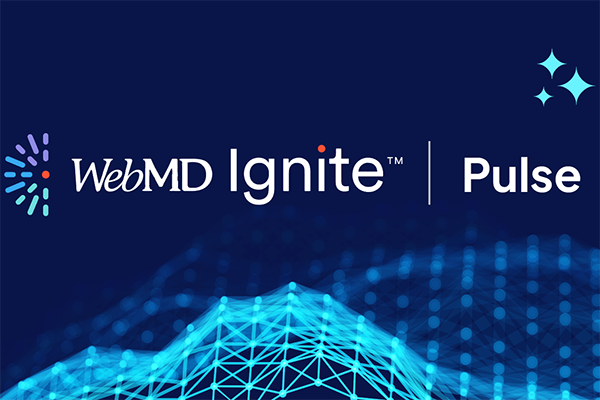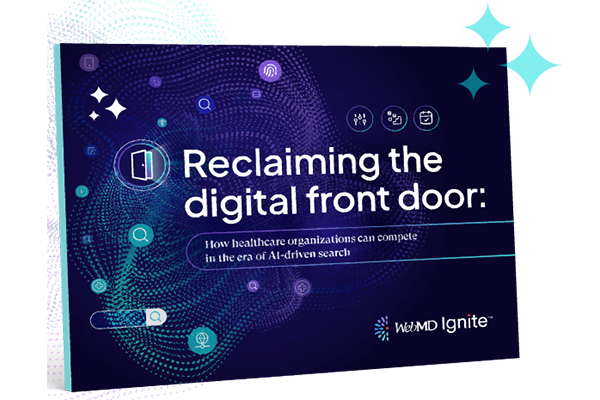Editor's Note: This blog was published prior to the transition to WebMD Ignite.
Targeted marketing has become a cornerstone of a successful marketing strategy. Why? Because today’s consumers crave personalization. By refining their target audience, health systems can speak directly to a clearly defined, like-minded set of individuals, customizing a message that resonates and promotes engagement. Even the best ad copy or design will be ineffective if its reach is too broad; thus, the larger the health system, the more refined your target personas must become.
Most major health systems have a dedicated team of marketing analysts supporting the targeting process — sifting through first, second, and third-party data, filtering across geographies and service lines, and using propensity models to pinpoint the most effective or profitable group. However, it’s critical that the data your team relies on is accurate to decrease the risk of mistargeted campaigns and minimize wasted time and resources. In other words, your investment in advanced martech and consumer data sources should be re-evaluated annually to ensure you are using the most current information and technology.
Medical marketing is going to become more competitive as hospitals adopt more advanced technology —and health systems need to adapt sooner rather than later, or risk being overrun by competitors. This means setting up data-driven campaigns that reach exactly the right prospects at the right time, with the right message, over the right channels. In this post, we’ll discuss how to leverage technology to refine your targeting and launch successful, profitable campaigns every time.
What is targeted marketing and why is it so important?
Healthcare providers all too often fall into the generalist trap when marketing to consumers, thinking that their vast assortment of therapies and services warrant mass-marketing tactics. They mistakenly assume that any prospect is a good prospect, taking a “spray and pray” approach and hoping for the best. Sometimes these campaigns yield results, but today’s consumers are no longer receptive to messages that don’t resonate on a personal level.
Thus, healthcare marketers have begun to pursue targeted marketing — the process of breaking down the healthcare market into distinct segments — to more accurately and appropriately address the needs and desires of various customer groups. Targeted healthcare marketing involves three activities:
- Market Segmentation, wherein a market is divided into smaller groups of individuals with common characteristics
- Targeting, wherein marketers select the most attractive segments to pursue in each campaign
- Positioning, wherein content is created to appeal to the target segment’s needs or desires and ultimately further engage them
Several key factors come into play when refining a target market. These include clinical information from your EMR combined with third-party data including geographic location, demographics (such as age, income, gender, and occupation), psychographics (lifestyle, hobbies, and preferences), and behavior patterns. A healthcare customer relationship management platform (CRM) turns this wealth of data into
360-degree profiles of patients, consumers, and households in your market to enable highly personalized targeting.
With the wide range of advanced tools and marketing technologies available today, health systems have no excuse not to engage in targeted marketing. By doing so, you’ll not only increase the number of qualified leads acquired per campaign, but also improve patient satisfaction and engagement. This translates into lower marketing costs and a higher return on investment.
What are the steps to refining your target market?
When zeroing in on data to refine your target market, remember that patients and consumers are individuals. Each prospect will be at a different stage along the patient journey, with different needs and expectations. Some may be looking for preventive healthcare, while others need urgent help with a chronic or debilitating illness. Those without health insurance may wait until the very last minute to seek treatment, unaware of alternative options.
To target and engage patients successfully, marketers must communicate with each group separately using relatable language, accessible channels, and services they identify with. Women between the ages of 23 and 40, for instance, may be a good target for maternity services. Yet there are subsegments within this group that might be offended or disheartened by a maternity campaign, such as those battling a life-threatening illness or otherwise medically unable to bear children.
Refining your target market using all available data and resources reduces the chances that your ads will be served to ineligible or disinterested consumers. Follow these steps to make sure the segmentation process is thorough enough to guarantee a profitable campaign:
- Identify the target market for your chosen healthcare service(s) based on basic geographic and demographic information
- Begin the segmenting process by creating subgroups based on need or propensity
- Evaluate the viability of each subgroup: Are they measurable? Responsive? Accessible?
- Construct segment profiles (personas) to better understand your target market on a personal level
- Evaluate the attractiveness of each subgroup and prioritize accordingly
It’s through this exercise you can hyper-personalize touchpoints and improve results. This is the beginning of deploying intelligent engagement strategies because they rely on a deep understanding of your audience.
What technologies do you need for targeted marketing?
For successful target marketing, health systems need to ensure their martech stack is sophisticated enough to power complex, dynamic campaigns and integrate with all relevant data sources. A healthcare CRM loaded with is the most vital tool to invest in. It breaks down traditional data silos to uncover market dynamics, top growth opportunities, and best next actions based on consumer, patient, provider, and claims data, as well as provider activity and referral trends.
These insights identify the most valuable patients and consumers likely to need high-priority services in the next 12 months. Once campaigns are in-flight, marketers get real-time performance insights with suggestions for how to refine channels, content, or segments.
An audience analysis tool is invaluable for automating list refinement. With a good tool, you gain a deep understanding of your patients by consolidating information like patient demographics, their digital footprint, hospital contact center activity, clinical information, and more. With this data in one place, you create audiences that are unified by specific needs and preferences.
Ideally, you’ll then apply one of many predictive models to anticipate a patient’s next healthcare need, allowing for even more intelligent personalization. The refined list is now ready for use across any number of engagement efforts, such as a nurturing journey, website personalization, or even a contact center queue.
When these technologies are combined, marketers can begin to answer important questions that shape their targeted strategy. For example, which sub-segment is most likely to require knee replacement surgery? Which geographic regions represent the most untapped opportunity? Which orthopedic procedure is most likely to help grow the service line as a whole? With the right technology, you won’t only answer these questions — you'll be able to harness your data and unveil which actions will drive growth and revenue for the health system.
Final thoughts
When beginning market research, it’s difficult to know where to focus. Is social media or traditional advertising more effective for cardiology prospects? How should we spend our budget across channels? Who, exactly, are we trying to reach?
Refining your target market will answer these questions and create a clear pathway to success. There is a wealth of consumer and patient data available to health systems today, but you need the right technology and analytics to properly plan, launch, and measure each campaign over time. By crafting personalized, relevant messages and delivering them to high-value consumers, your health system will drive high-value service line growth while extending patient lifetime value.





